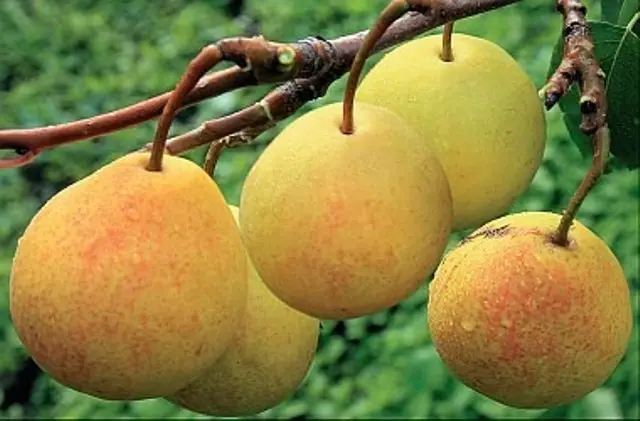Contents
The pear, together with the apricot and the apple, forms the “triad” of our gardens as the most common fruit trees. This tree has a lot of the most diverse varieties in terms of their characteristics. One of the most popular varieties is the Bergamot pear. It has great variety. We will consider the main subspecies of this pear in this article.
Description of bergamot pear
Pear Bergamot means a combined variety, which includes trees, fruiting flat (flattened shape) and rounded fruits.

This variety was very widespread in the USSR, and had a territorial reference: in the western regions of the country they grew Polish Bergamot (poorly tolerates transportation), in the central – Red Bergamot (has increased resistance to climate change), in the southern and southwestern regions – Autumn Bergamot or Maslinovka.
This pear was bred in the city of Bergamo. It includes a large number of species: Autumn, Summer Red, Muscat, Volga and many others.

The pear variety Bergamot has a fairly large distribution: it is grown throughout Europe, Our Country and China. Most of all, it has become widespread in Italy, Spain and France.
This group of fruit trees has both cold-resistant varieties (more common in Our Country) and southern varieties (more common in Europe). The latter have sweeter and juicier fruits.
Fruiting is annual, and the yield is quite high. A distinctive feature, in addition to a flattened spherical shape and small size, is the high content of arbutin and glorogenic acid in fruits. Due to the presence of these substances, pears are very useful, especially for people who have diseases of the genitourinary system, as they have a positive effect on the functioning of the liver, gallbladder, and also contribute to the removal of bile, toxins and salts.
Fruit ripening occurs in autumn, and they are stored for only about two months. How they look can be seen in this photo.

This variety is very demanding on soil moisture, so such trees need to be watered a lot and often.
Video “Variety of pear varieties”
In this video you can get acquainted with the main characteristics of various types of pears, including ours.
Let us consider in more detail some subspecies of the Bergamot pear variety.
Variety Bergamot Moscow
Bergamot Moscow is a medium-sized tree with a compact crown, which is characterized by medium foliage. The formation of fruits occurs on spears and annelids of different ages. The color of the shoots can be from light brown to brown.
The leaves are oblong and oval in shape with serrated edges. They are attached to a short handle. The lenticels are large and elongated.
The tree bears fruit for 4 years. Characterized by a long flowering period. The fruits are ribbed and rather large (up to 150 g). Their color is yellow-green with a slight red or red-brown blush. Pear pulp is juicy and dense. They have a sweet and sour taste. Harvesting is carried out in early September. The average yield per tree is about 20 kg.

This fruit tree has increased frost resistance and resistance to scab, brown spot and fruit rot.
Self-fertility is characteristic, but to increase productivity, pollination with pears Marble, Cosmic and Elegant Efimova is used.
The disadvantages of the variety include a short period of storage of fruits and a change in their taste characteristics (they become tart and sour) in dry years.
Variety Bergamot autumn
Is the most popular. Bergamot Autumn is a medium-sized tree with a rare reverse pyramidal crown. Its shoots are greenish and rather thick with slightly drooping ends.
Fruiting occurs at 7-9 years after planting. The size of the fruits is medium, and their color is dark green with a brown or brick blush. Their mass does not exceed 80 g. The pulp of pears is granular and white. They taste wine-sweet and have a pleasant aroma. They ripen in early autumn and are stored for up to 20 days.

The leaves are oblong and ovate, as well as short-pointed and entire.
The life expectancy of the tree is very long, and the variety itself is unpretentious to various climatic conditions. Not resistant to diseases, especially scab. As a result, it has a low yield. Characteristic average frost resistance.
The pear is self-fertile, but Tonkovetka and Bessemyanka varieties can be used as pollinators.
This variety is most widespread in Lithuania, Latvia and Our Country.
Disadvantages: low resistance to diseases, freeze in severe frosts, mediocre taste.
Variety Bergamot nutmeg
The origin of this variety is unknown. It is found mainly in old gardens. It can grow up to 8 m in height, and the crown in diameter can reach 12 m. It is dense and broadly spherical with thick branches. The wood stamp is quite thick.
The leaf is elongated, thick and medium in size. Its edge is serrated.
Blooms early, medium sized flowers. Trees are characterized by high yield, which is preserved even in old pears (at the age of 60 years). The weight of one pear is up to 100 g. The color of the fruit is yellow-green, with a dull blush. During the season it can produce up to 300 kg of crop, and in lean years – up to 50 kg. The pulp is creamy and juicy, the taste is pleasant. Fruit ripening occurs at the end of July. Keep no more than five days. The fruits are used both fresh and for making jams and preserves.

This variety has sufficient winter hardiness. Even with very severe winters, there were no signs of freezing. Also characterized by high resistance to various diseases. But the fruits are very affected by wasps. They often eat them up. You can fertilize with the Bere Ardanpon variety. The downside is the rapid ripening of the fruit.
Knowing the above characteristics of the different varieties of Bergamot pears will allow you to decide on the most suitable type for your garden.









